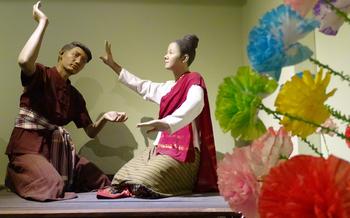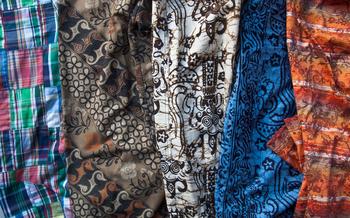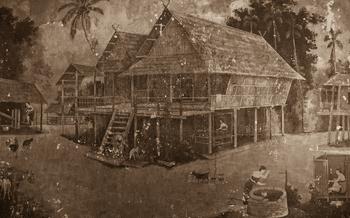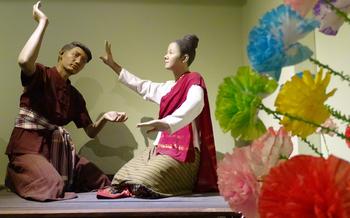
Lanna Folklife Museum
- Historical Background
- Location and Accessibility
- Museum Highlights
- Traditional Lanna Architecture
- Traditional Lanna Craftsmanship
- Lanna Music and Dance Performances
- Lanna Cuisine and Gastronomy
- Religious and Spiritual Artifacts
- Interactive Workshops and Activities
- Educational Programs for Visitors
- Museum Shop and Souvenirs
- Photography and Social Media
- Accessibility for Visitors with Disabilities
Historical Background
Nestled in the heart of Thailand's Phrae Province, the Lanna Folklife Museum stands as a testament to the rich cultural heritage of the Lanna Kingdom, which once ruled over a vast region encompassing parts of present-day Thailand, Laos, and Myanmar. Founded in the 13th century, the Lanna Kingdom flourished for over 500 years, leaving an indelible mark on the region's art, architecture, and traditions.
The Lanna Folklife Museum, established in 1977, plays a crucial role in preserving and showcasing this unique cultural legacy. Housed in a beautifully restored traditional Lanna-style building, the museum features an extensive collection of artifacts, exhibits, and interactive displays that bring to life the customs, beliefs, and daily life of the Lanna people.
Location and Accessibility
The Lanna Folklife Museum is strategically situated in the heart of Phrae, a serene province in northern Thailand. Nestled amidst lush greenery and tranquil surroundings, the museum's exact address is Mueang Phrae District, Phrae 54000, Thailand.
Reaching the museum is a breeze, with multiple transportation options available. For those arriving by air, the nearest airport is Phrae Airport (PRH), located approximately 10 kilometers from the city center. From the airport, you can easily hail a taxi or rent a car to complete your journey to the museum.
For those opting for land transportation, the museum is well-connected by road. Regular bus services operate from major cities in Thailand, including Bangkok, Chiang Mai, and Lampang. Once in Phrae, local buses or tuk-tuks can be boarded for the final leg of the journey to the museum.
Self-driving enthusiasts can embark on a scenic road trip to Phrae. The city is conveniently accessible via Highway 101, which offers breathtaking views of the surrounding countryside. Ample parking spaces are available at the museum, ensuring a hassle-free visit for those arriving by car.
Museum Highlights
The Lanna Folklife Museum is a treasure trove of unique artifacts and exhibits that showcase the rich cultural heritage of the Lanna Kingdom. Visitors can explore a diverse range of displays, including traditional Lanna clothing, intricately carved wooden sculptures, exquisite silver jewelry, and ancient musical instruments. Interactive experiences bring the museum to life, allowing visitors to try their hand at traditional Lanna crafts, such as weaving, pottery, and woodcarving.
Among the must-see exhibits is a remarkable collection of Lanna textiles. These stunning fabrics, intricately woven with vibrant colors and intricate patterns, are a testament to the skill and artistry of Lanna craftspeople. Visitors can also admire a beautiful display of traditional Lanna costumes, which showcase the region's unique fashion and style.
Traditional Lanna Architecture
The Lanna Folklife Museum is housed in a stunning traditional Lanna-style building, showcasing the unique architectural heritage of the region. Built entirely from wood without the use of nails, the structure is supported by intricate wooden pillars and beams, demonstrating the remarkable craftsmanship of Lanna builders. The museum's facade is adorned with intricate carvings and sculptures, reflecting the influence of both Thai and Burmese architectural styles. Inside, visitors can appreciate the vaulted ceilings, open floor plans, and natural ventilation, all characteristic of Lanna architecture designed to adapt to the region's tropical climate. The museum building itself is a testament to the rich architectural heritage of the Lanna Kingdom and serves as a living example of traditional construction techniques.
Traditional Lanna Craftsmanship
The Lanna Folklife Museum is a treasure trove of traditional Lanna crafts and techniques that have been passed down through generations. Skilled artisans demonstrate their mastery in various traditional crafts, such as woodcarving, weaving, pottery, and silversmithing. Visitors can witness these artisans at work, creating intricate pieces that showcase the unique artistry and craftsmanship of the Lanna people.
Workshops and classes are also offered at the museum, providing visitors with an opportunity to learn from these skilled artisans and try their hand at creating their own Lanna crafts. Whether it's learning the intricate techniques of woodcarving, the delicate art of weaving, or the precise skills of silversmithing, these workshops offer a unique and immersive experience that allows visitors to connect with the cultural heritage of the Lanna people.
Lanna Music and Dance Performances
The Lanna Folklife Museum offers a unique opportunity to witness traditional Lanna music and dance performances. These performances, typically held on weekends or during special events, showcase the rich cultural heritage and artistic traditions of the Lanna region.
Experience the mesmerizing sounds of the phin, a traditional Lanna lute, as skilled musicians play melodious tunes that evoke a sense of tranquility and serenity. Dancers, adorned in vibrant and intricately designed costumes, perform graceful and expressive movements, telling stories of love, loss, and the beauty of nature.
The Lanna performing arts are deeply rooted in the region's history and culture. Each performance is a testament to the creativity and skill of Lanna artisans and artists, who have passed down these traditions from generation to generation.
Visitors to the museum are invited to immerse themselves in the enchanting world of Lanna music and dance, gaining a deeper understanding of the region's cultural identity and the enduring legacy of its artistic expressions.
Lanna Cuisine and Gastronomy
The Lanna Folklife Museum celebrates the diverse and delectable cuisine of the Lanna region. A dedicated section of the museum showcases traditional Lanna ingredients, cooking utensils, and culinary practices. Visitors can learn about the unique flavors, textures, and aromas that characterize Lanna cuisine, which blends influences from various ethnic groups and neighboring countries. Interactive displays allow visitors to grind spices, mix sauces, and prepare simple Lanna dishes under the guidance of experienced chefs. Cooking demonstrations provide an opportunity to witness the culinary artistry of local experts, who share their knowledge of traditional recipes and techniques. Visitors can also indulge in food tasting experiences, savoring the authentic flavors of Lanna cuisine and appreciating the cultural significance behind each dish.
Religious and Spiritual Artifacts
The Lanna Folklife Museum houses a significant collection of religious artifacts and sculptures, offering visitors a glimpse into the spiritual beliefs and practices of the Lanna people. Buddhism is the predominant religion in the region, and the museum showcases various Buddha images, stupas, and other sacred objects. These artifacts provide insights into the history and evolution of Buddhism in Thailand, particularly in the Lanna Kingdom.
Additionally, the museum exhibits animist objects that reflect the indigenous beliefs and traditions of the Lanna people. Animism, the belief in spirits residing in natural objects, has been an integral part of Lanna culture since ancient times. Visitors can see animist sculptures, masks, and other ritual objects that were used to communicate with spirits and seek their blessings or protection.
The Lanna Folklife Museum serves as a repository of Lanna religious and spiritual heritage, providing visitors with a deeper understanding of the diverse beliefs and practices that have shaped the culture of this region.
Interactive Workshops and Activities
The Lanna Folklife Museum offers a range of interactive workshops and activities for visitors to immerse themselves in Lanna culture and traditions. These hands-on experiences provide a deeper understanding of the region's rich heritage and allow visitors to connect with local artisans and craftspeople.
One popular workshop is the Lanna weaving class, where participants learn the basics of traditional Lanna textile weaving using a manual loom. Under the guidance of skilled instructors, visitors can create their own unique woven pieces, such as scarves, bags, or cushion covers. The workshop includes a demonstration of the entire weaving process, from preparing the yarn to creating intricate patterns and designs.
Another highlight is the Lanna cooking class, where visitors can learn to prepare delicious and authentic Lanna dishes using fresh, local ingredients. Participants will be guided through the process of cooking traditional dishes such as khao soi, a northern Thai curry noodle soup, and sai ua, a northern sausage made with pork, lemongrass, and other spices. The class also includes a communal meal, where participants can savor their creations and share their culinary experiences.
For those interested in Lanna music and dance, the museum offers workshops on traditional instruments such as the khene, a bamboo mouth organ, and the khaen, a bamboo xylophone. Visitors can learn basic techniques and rhythms, and even try their hand at composing their own melodies. Dance workshops introduce participants to the graceful movements and intricate footwork of Lanna classical dance, providing a glimpse into the region's performing arts traditions.
These interactive workshops and activities not only provide a fun and engaging way to learn about Lanna culture but also contribute to the preservation and promotion of these traditions. Visitors leave the museum with a deeper appreciation for the region's rich heritage and a newfound connection to the local community.
Educational Programs for Visitors
The Lanna Folklife Museum offers a range of educational programs and guided tours for visitors who seek a deeper understanding of Lanna culture and history. These programs are designed for groups and individuals of all ages and interests, providing an immersive and interactive learning experience.
Guided tours led by knowledgeable museum docents take visitors on a journey through the museum's exhibits, offering insights into the significance of each artifact and display. Visitors can learn about the history and development of Lanna society, its unique traditions and customs, and the influences of various ethnic groups that have shaped the region.
For those seeking a more hands-on experience, the museum offers workshops and activities that allow visitors to participate in traditional Lanna crafts and traditions. These workshops may include learning how to weave intricate textiles, create beautiful lacquerware, or play traditional musical instruments. By engaging in these activities, visitors gain a deeper appreciation for the skills and artistry of Lanna artisans and the cultural significance of their crafts.
The museum also provides educational resources and materials for researchers and scholars interested in studying Lanna culture and history. These resources include an extensive library of books, manuscripts, and documents, as well as access to museum archives and collections.
Whether you are a casual visitor, a student, or a researcher, the Lanna Folklife Museum offers a wealth of educational opportunities to explore and learn about the rich cultural heritage of Thailand's northern region.
Museum Shop and Souvenirs
The Lanna Folklife Museum offers a unique opportunity to support local artisans and preserve Lanna traditions by purchasing souvenirs and handicrafts from the museum shop. The shop features a wide range of authentic and locally-made products, including traditional textiles, pottery, wood carvings, and other handmade crafts. Visitors can browse and select items that resonate with them, contributing directly to the sustainability of Lanna cultural heritage. By purchasing souvenirs, visitors not only take home a piece of Phrae's rich history but also play a vital role in supporting the local artisans who keep these traditions alive.
Photography and Social Media
The Lanna Folklife Museum encourages visitors to capture and share their experiences through photography and social media. However, it's important to respect the museum's guidelines and maintain appropriate etiquette. Flash photography is not permitted to preserve the integrity of the artifacts and exhibits. Tripods and selfie sticks are also discouraged to ensure the safety of visitors and the museum's collection.
When sharing your photos and experiences on social media, please use the official museum hashtags to connect with other visitors and enthusiasts. Tagging the museum's social media accounts will also allow them to feature your content and share it with their followers. By adhering to these guidelines, you can contribute to the museum's mission of preserving and promoting Lanna culture while also sharing your unique perspective with the world.
Accessibility for Visitors with Disabilities
The Lanna Folklife Museum is committed to ensuring an inclusive and welcoming environment for all visitors, including those with disabilities. Wheelchair ramps and elevators provide easy access throughout the museum, allowing visitors to navigate the exhibits and facilities with ease. Accessible restrooms are also available for the convenience of visitors with special needs. The museum staff is trained to assist visitors with disabilities, providing support and guidance as needed. By creating an accessible environment, the Lanna Folklife Museum ensures that everyone has the opportunity to experience and appreciate the rich cultural heritage of the Lanna Kingdom.




